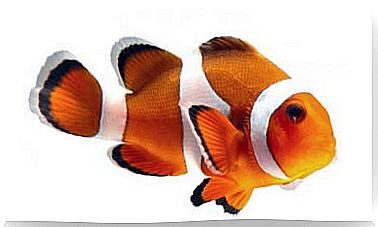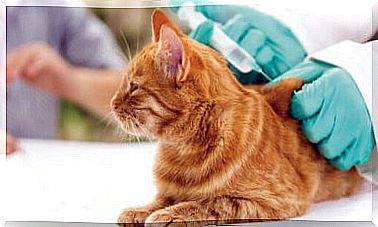Stonefish, The Almost Invisible Inhabitant Of The Reef
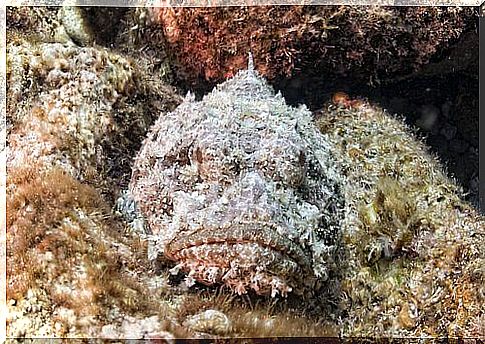
Although it may seem, it is not a stone. It is a living creature that takes the form of a rock and can hurt beyond anyone’s expectations. It is the stonefish, a deadly poisonous species that camouflages itself as a grayish or brownish rock.
People, when swimming in the open sea, tend to mistake it for a boulder and step on it, leading to situations that put them in danger of life.
Stepping on an animal of this species is very dangerous, as the pressure exerted on it causes it to spread its thorns and release a very powerful poison.
The toxin causes so unbearable pain and paralysis that if the person is not treated in time, it can kill the person.
This specimen is non-aggressive and does not attack unless provoked, and its defense mechanism is activated if we step on it by accident.
Physical appearance
True to its name, the rockfish looks like a shell of rock or a piece of rubble at the bottom of the sea. But if you look closely, you can find some interesting features.
Most stonefish are brown or gray in color with yellow, orange or red spots on the body. Estuary rockfish are usually brown or reddish brown.
The orange bulges, like sponges found on some of these animals, can make it look like a piece of debris on the coral reef.
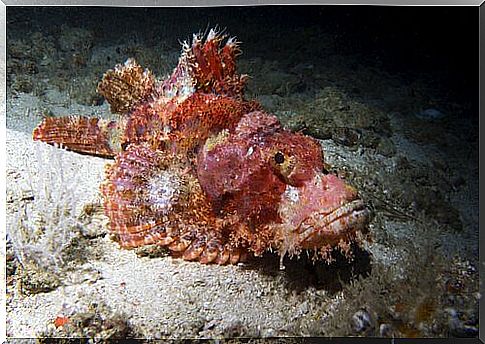
In general, its size reaches 35 centimeters in length, although there are records of individuals with up to 50 centimeters. This animal can weigh about 2.5 kilos.
Its eyes are huge, and their location can help distinguish reef and estuary species. The eyes of the latter are taller and separated by a ridge, and those of the reef rockfish are separated by a deep depression.
One of the most important features of this marine species is its dorsal fin modified in the shape of a needle, at the base of which are pressure-sensitive poisonous glands.
It has 13 sharp spines on its dorsal fin and, whenever it feels threatened, it raises them to defend itself.
Along with the 13 dorsal fin spines, it has two pelvic spines and three anal spines, but they remain buried within the skin. This fish has no scales; his husky skin is what gives him the appearance of rough rock.
Habitat and reproduction
Rockfish are found in coastal regions of the Indian and Pacific oceans, and in the waters of northern Australia.
Its main habitat is coral reefs. However, they can also be found near and under rocky overhangs, mud or sand, at tidal inlets.
Although rockfish are largely marine, some of them can also live in rivers.
Both reef and river rockfish exhibit the same reproduction pattern. The female carries within her the unfertilized eggs, which are released to the seabed or a rock platform.
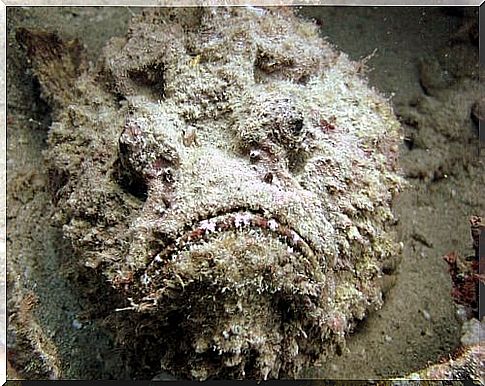
When the male fish reaches this area, it splashes its sperm into its eggs. When fertilized, eggs hatch in three days.
Newborns tend to be easy prey for other fish, so only a few of them survive and reach adulthood.
Other Interesting Facts About Stonefish
Stonefish feed mainly on small fish and shrimp. This species is a patient hunter capable of waiting for hours until a prey is within reach to be able to surprise it.
Sometimes it is buried in the sand in such a way that only the top of the head and the thorns remain exposed. If the prey is located behind its head, it raises its spines to frighten and drive it into the attack area.
The venom glands located at the base of these spines contain neurotoxins. The sting can produce severe pain and swelling.
Eventually, they can cause tissue death and paralysis, depending on the depth of penetration and the number of spines.
After discharging the venom, the glands need a few weeks to replenish. The amount of venom discharged is proportional to the degree of pressure applied.
